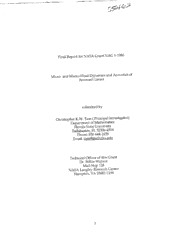
NASA Technical Reports Server (NTRS) 20020017762: Micro- and Macro-Fluid Dynamics and Acoustics of Resonant Liners PDF
Preview NASA Technical Reports Server (NTRS) 20020017762: Micro- and Macro-Fluid Dynamics and Acoustics of Resonant Liners
Final Report for NASA Grant NAG 1-1986 Micro- andMacro-Fluid Dynamics andAcoustics of ResonantLiners submitted by Christopher K.W. Tam(Principal Investigator) Department ofMathematics Florida SkateUniversity Tallahassee,FL32306-4510 Phone:850-644-2455 Email: [email protected] Technical Officer of this Grant Dr. Willie Watson Mail Stop 128 NASA Langley Research Center Hampton, VA 23681-2199 Summary ofResearch Grant NAG 1-1986 Theobjectivesof this projectare: 1.Toperform direct numerical simulation of themicro-fluid and acoustic fields of aresonantacousticliner. 2. Toinvestigate thephysical processesby which incident sound waves aredamped by theacousticliner Wewould like to report thatour researchwork andresults (supported by this grant) havefulfilled both objectivesof thegrant. The following is a summary of theimportant accomplishments. a. Two dimensional direct numerical simulation of the flow and acoustic field around the cavity ofresonantliner were successfullycarried out. b. Thesimulations of (a)wereextendedtoinclude alaminar grazing flow. C. The numerical simulations provided strong evidence that there are 2 principal mechanisms by which a resonant liner damps out an incident acoustic wave. At low SPL, damping is achieved by viscous dissipation associated with an oscillatory fluid layer adjacent to the walls of the opening of the cavity. At high SPL (also depending on the sound frequency) the main mechanism of damping is the transfer of acoustic wave energy to micro-vortices shed at the mouth of the resonator. The shed vortices are eventually damped out by molecular viscosity. No oscillatory turbulent jet at the mouth of the resonator was observed in all the simulations even at SPL as high as 160 dB. This is somewhat contrary to traditional thinking of liner dissipation mechanism. d. A validation test was performed by comparing the computed dissipation coefficients (not impedance) with impedance tube measurements done at GTRI. Some resources of this grant were used to support the development of new e. CAA methods. (Our work on numerical simulation of acoustic liners has benefited by the availability of these improved methods). Publications supported by the grant. 1. Tam, C.K.W. and Kurbatskii, K.A. Microfluid dynamics and acoustics of resonant liners, AIAA Journal, 38, 1331-1339, 2000. 2 . Tam, C.K.W. and Kurbatskii, K.A. A wavenumber based extrapolation and interpolation method for use in conjunction with high-order finite difference schemes ,Journal of Computational Physics, 157, 588-617, 2000. 3. Tam, C.K.W., and Aganin, A. Computation of transonic nozzle sound transmission and rotor problems by the dispersion-relation-preserving scheme. Proceedings of the 3rd CAA Workshop on Benchmark Problems, pp 191-202, NASA CP-2000-209790, Aug 2000. 4. Kurbatskii, K.A. and Tam, C.K.W. Micro-fluid dynamics of a resonator in a grazing flow. AIAA paper 2000-1951. 5. Tam, C.K.W., Kurbatskii, K.A., Ahuja, K.K. and Gaeta, R.J. A numerical and experimental investigation of the dissipation mechanisms of resonant acoustic liners (with K.A. Kurbatiskii, K.K. Ahuja & R.J. Gaeta) Journal of Sound and Vibration, 245, 545-557, 2001 6. Tam, C.K.W. and Kurbatskii, K.A. Multi-size-mesh multi-time-step Dispersion-Relation-Preserving scheme for multiple scales aeroacoustic problems. AIAA paper 2002-0224. To appear in the International Journal of Computational Fluid Dynamics, 2002.
